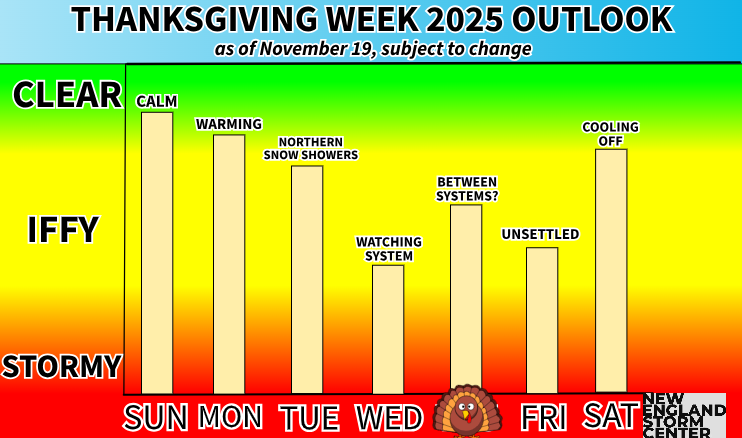Chances for Showers as Northern New England's Flash Drought Continues
- Tim Dennis
- Sep 13
- 4 min read
The best chance for showers in the next week will come Sunday, but this northern stream system is quickly trending toward the drier end as a weak, moisture-starved front drops through the region. A trough will be over the region aloft, with a cold pool developing. With warmer surface temperatures, this will create an unstable atmosphere, allowing for large, puffy cloud development and scattered showers and storms. Showers in this kind of setup tend to be small and localized.
Below: FV3 showing potential weather Sunday afternoon:

After this system, another large, sprawling high pressure will settle over New England, keeping the tranquil weather around for much of next week. Flow around this high will allow for a warm-up, with (maybe?) the last run at widespread 80s for the season. This will come around midweek. The weak flow of the high will likely allow for a sea breeze, keeping coastal areas a notch cooler. Overall, northern New England will have the better chance at above average temperatures next week, closer to the center of the ridge.
Below: Temperature departure from average Wednesday afternoon:

In the last update on Thursday, a small portion of New England (western New Hampshire) was upgraded to "extreme drought" status. Over 50% of northern New England is currently seeing at least "severe drought" status. This is in stark contrast to southern New England, which is currently seeing 0% in the severe category (though over 50% of southern New England is currently experiencing at least "abnormally dry" conditions).
Below: Current US drought status in New England (the official US drought monitor, seen below, is updated once a week on Thursdays):

What has developed in northern New England is what's known as a flash drought. While both flash droughts and more traditional droughts (obviously) need below average precipitation to develop, more specific atmospheric conditions also need to be present to allow for a flash drought. A flash drought is defined as the rapid onset and intensification of drought conditions.
This quick-moving drought was spurred not only by low precipitation rates, but also by increased solar radiation from high pressure and sunny days dominating and persistently below average humidity over the past few weeks. Both of these factors have aided in high evaporation of ground moisture, allowing for the quickly developing drought. Portions of northern New England have been upgraded 2 to 3 categories since the beginning of August. Going back three months, to the June 10th update, only Cape Cod and Nantucket were experiencing a drought (with southwest Maine seeing abnormally dry conditions).
Below: side-by-side comparison of northeast drought status from June 10th (1st image) and September 11th (2nd image):
While all of New England has been dry with low humidity and plenty of sunshine, southern New England hasn't seen the kind of precipitation deficits of northern New England, which has led to a much more gradual increase in drought conditions (as seen above). In the last 60 days, much of Vermont and New Hampshire have seen rainfall deficits of 4 to 6 inches. Much of southern New England has deficits of 1-3 inches during this time. The overall deficit has been centered over west-central New Hampshire and the southern half of Vermont.
Below: 60-day precipitation departure from average:

As we hinted at earlier, drought status is not just about the sheer amount of rainfall (or lack thereof). It also has to do with the overall moisture content within the soil, and how quickly that evaporates. While rainfall is, of course, the biggest factor in soil moisture, there are other factors that go into how quickly it leaves the ground.
Current top soil moisture percentiles are at 2-10% of normal across much of Vermont and New Hampshire. This is why a couple decent rain events punctuated by long periods of dry weather in between (which has generally been the case recently) does not cure a drought. The long periods of dry, sunny weather with low humidity allows for the rapid evaporation of the moisture within the soil that may have recently been rained on.

Looking at the forecast, a ridge of high pressure will dominate New England over the next week, allowing for dry, sunny and warm weather to continue. Showers are expected to develop this afternoon and Sunday afternoon, but showers are not expected to be widespread. An area of low pressure may creep up the Atlantic coast later next week. This could potentially bring some unsettled weather to the region, but trends are currently headed in the drier direction with this one.
A cold front will drop into New England late next week, which could also present shower chances. Overall, it looks like New England will be surrounded by troughs over the Midwest, Canada and the Atlantic, but high pressure is favored to "protect" New England from these, allowing for dry weather over the next week. The main system to watch will be the system working up the east coast. This one will have the best chance to trend toward a wetter scenario.
Below: Current Weather Prediction Center 7-day precipitation forecast:








Comments